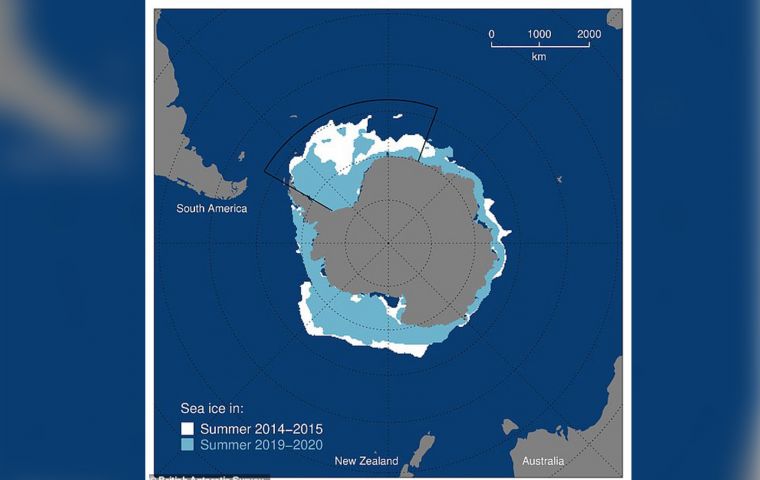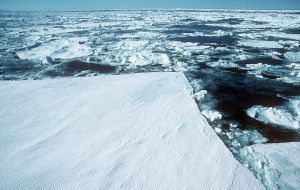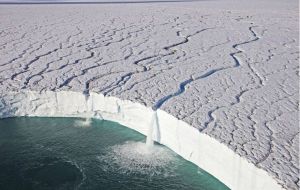MercoPress. South Atlantic News Agency
Sea ice in the Weddell Sea has decreased by one million sq kilometers in five years
 Ice loss occurred due to a series of severe storms in the Antarctic summer of 2016/17, along with the re-appearance of an area of open water in the middle of the ‘pack ice’ (known as a polynya)
Ice loss occurred due to a series of severe storms in the Antarctic summer of 2016/17, along with the re-appearance of an area of open water in the middle of the ‘pack ice’ (known as a polynya)  Ice loss occurred due to a series of severe storms in the Antarctic summer of 2016/17, along with the re-appearance of an area of open water in the middle of the ‘pack ice’ (known as a polynya)
Ice loss occurred due to a series of severe storms in the Antarctic summer of 2016/17, along with the re-appearance of an area of open water in the middle of the ‘pack ice’ (known as a polynya)  In December 2016, a number of intense and unseasonal storms developed in the Weddell Sea and drew warm air towards the Antarctic, melting a large amount of sea ice (Pic C. Cartwright)
In December 2016, a number of intense and unseasonal storms developed in the Weddell Sea and drew warm air towards the Antarctic, melting a large amount of sea ice (Pic C. Cartwright) Scientists have discovered that summer sea ice (*) in the Weddell Sea area of Antarctica has decreased by one million square kilometres – an area twice the size of Spain – in the last five years, with implications for the marine ecosystem. The findings are published this month in the journal Geophysical Research Letters.
An international team of researchers studied satellite records of sea ice extent and weather analyses starting in the late 1970s to understand why summer sea ice in the Weddell Sea area of Antarctica has reduced by a third over the last five years. They found that ice loss occurred due to a series of severe storms in the Antarctic summer of 2016/17, along with the re-appearance of an area of open water in the middle of the ‘pack ice’ (known as a polynya), which had not occurred since the mid-1970s.
Lead author Professor John Turner, a climate scientist at British Antarctic Survey, says: “Antarctic sea ice continues to surprise us. In contrast to the Arctic, sea ice around the Antarctic had been increasing in extent since the 1970s, but then rapidly decreased to record low levels, with the greatest decline in the Weddell Sea. In summer, this area now has a third less sea ice, which will have implications for ocean circulation and the marine wildlife of the region that depend on it for their survival.”
The ocean around Antarctica freezes and doubles the size of the continent in the austral winter, with the sea ice extent reaching over 18 million square kilometers by late September. Through the spring and summer, the sea ice almost completely melts in most parts of the Antarctic, with only the Weddell Sea retaining a significant amount of sea ice.
There are few storms around the Antarctic in the austral summer, but in December 2016, a number of intense and unseasonal storms developed in the Weddell Sea and drew warm air towards the Antarctic, melting a large amount of sea ice. The ice-free ocean absorbed energy from the Sun and then created a warm ocean temperature anomaly that still persists today.
The winter of 2016 also saw the development of a polynya in the Weddell Sea, a large area of open water within the sea ice, which also contributed to the overall decline in sea ice extent. This polynya was created by the strong winds associated with the storms and unprecedented warm ocean conditions.
This recent rapid sea ice loss is affecting both the Weddell Sea ecosystem and the wider Antarctic wildlife/plants and animals. Many species, ranging from tiny ice algae and shrimp-like crustaceans called krill to seabirds, seals and whales, are highly adapted to the presence of sea ice. If the drastic changes observed continue, they will have repercussions throughout the food chain, from affecting nutrients to the reduction of essential habitat for breeding and feeding for vast numbers of animals, such as ice seals and some species of penguins.
Author and ecologist Professor Eugene Murphy from British Antarctic Survey says: “The dramatic decline in sea ice observed in the Weddell Sea is likely to have significant impacts on the way the entire marine ecosystem functions. Understanding these wider consequences is of paramount importance, especially if the decline in ice extent continues.”
Because of the large year-to-year variability in Antarctic sea ice extent the scientists cannot be sure if the ice in the Weddell Sea will in the short-term recover to the values seen before 2016 or whether they are seeing the start of the expected long-term decline of sea ice.
Researchers on this study were from British Antarctic Survey, the Indian National Centre for Polar and Ocean Research, Nanjing University, China and Victoria University of Wellington, New Zealand. (BAS)
Recent Decrease of Summer Sea Ice in the Weddell Sea, Antarctica by John Turner, Maria Vittoria Guarino, Jack Arnatt, Babula Jena, Gareth J. Marshall, Tony Phillips, C. C. Bajish, Kyle Clem, Zhaomin Wang, Tom Andersson, Eugene J. Murphy and Rachel Cavanagh is published in the journal Geophysical Research Letters.
(*) Sea ice: is frozen sea water generally around 1-2 m thick, but it is extremely important within the Antarctic environment as it provides a very effective cap on the ocean and limits the amount of heat that can be transferred from the relatively warm ocean below to the frigid atmosphere above.
Pack ice: sea ice that is not attached to the shoreline and drifts in response to winds, currents, and other forces; some prefer the generic term drift ice, and reserve pack ice to mean drift ice that is closely packed.



Top Comments
Disclaimer & comment rulesCommenting for this story is now closed.
If you have a Facebook account, become a fan and comment on our Facebook Page!